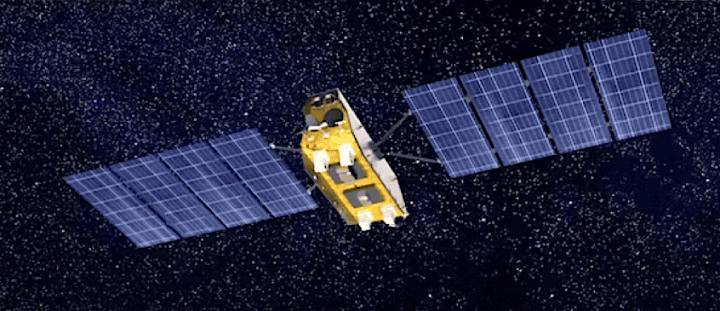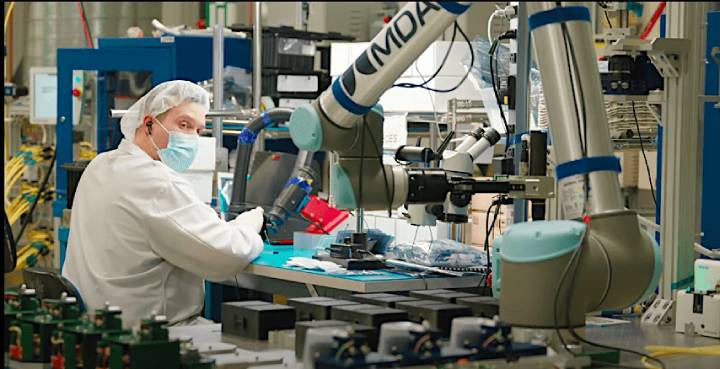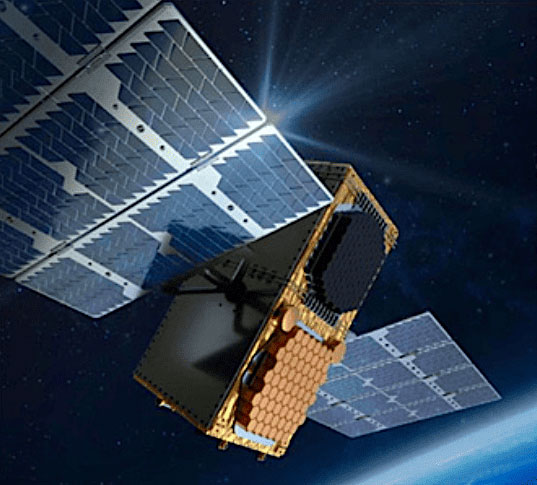 Not much is known about what MDA Ltd.’s Telesat Lightspeed satellite will look like. Contractors for the major subsystems have yet to be selected, and MDA is still sorting out which elements to build on its own, and which to purchase. What is known: The 198-satellite constellation will feature on-board processing, a new MDA-built digital beam-forming antenna, four laser communications terminals per satellite, an 11-year service life and around 700 kilograms of liftoff mass. (Source: MDA)
Not much is known about what MDA Ltd.’s Telesat Lightspeed satellite will look like. Contractors for the major subsystems have yet to be selected, and MDA is still sorting out which elements to build on its own, and which to purchase. What is known: The 198-satellite constellation will feature on-board processing, a new MDA-built digital beam-forming antenna, four laser communications terminals per satellite, an 11-year service life and around 700 kilograms of liftoff mass. (Source: MDA)
TUPPER LAKE, NY — MDA Ltd. said its contract to build 198 Telesat Lightspeed broadband satellites gives its new digital beam-forming antenna and on-board processor product line immediate credibility in a broadband-LEO market the company said includes a handful of credible prospective customers.
MDA’s contract is valued at 2.1 billion Canadian dollars ($1.55 billion), a striking reduction in price compared to a previous Lightspeed offer of $3 billion from Thales Alenia Space. Telesat has said there is no material difference in the performance of the two designs.
MDA said it’s still sorting out make-or-buy alternatives and has not yet selected its contractor team. Major decisions — among them the provider of the laser communications terminals (four per satellite) and of the satellite’s platform, or bus— are still ahead.
Telesat has lost its priority regulatory position for a Ka-band LEO constellation because of the program’s delays, so Lightspeed is no longer under regulatory pressure. But Telesat has said it wants launches of the satellites to start in mid-2026, with polar and global service starting in late-2027.
Telesat has already contracted for the launch of the 700-kilogram satellites aboard heavy-lift rockets but has publicized only a contract with Blue Origin’s New Glenn.
 MDA Chief Executive Mike Greenley. (Source: MDA video)
MDA Chief Executive Mike Greenley. (Source: MDA video)
In an Aug. 17 interview, MDA Chief Executive Mike Greenley described his company’s three-year journey with the Lightspeed project, how MDA went from being subcontractor to Thales Alenia Space to prime contractor and how this contract will be leveraged to win work on other broadband constellations.
Your contract with Telesat is firm, fixed-price and is signed, meaning it’s not subject to modification in Telesat’s due-diligence negotiations with Canadian government funding sources, correct?
Yes, that’s correct. We have a signed contract and we’re starting work. Like any contract, of course, there are clauses for things going wrong — termination for default, or termination for convenience, the normal clauses.
It has been two and one-half years since Telesat selected you as a subcontractor to build direct radiating antennas for the constellation, as a major subcontractor to Thales Alenia Space. Much of the market thought Lightspeed was no longer real.
It’s been a challenging time. This is a large, complicated project that has had a journey along the way. We’ve been involved in all the various forms of Telesat and teaming arrangements and roles on the project over the last five-plus years. As a result of that, and of our being in Canada, I would have had my own insights into Telesat’s relations with its funding sources — not exact details, but I can assess commitment and enthusiasm. I know I have a contract and that we’ll get this done.
The difference in the MDA price and the Thales Alenia Space price is remarkable. Is this a foreign-exchange issue, or the volume output of your expanded Montreal factory? How do you explain it?
We have great respect for Thales and they are an important customer to us. We team and partner on various opportunities. I think we work well together. That’s the nature of defense and aerospace and space — we’re all in “co-opetition” all the time. I would hope that this will continue.
And on the price difference?
Our goal has been to get down to an effective cost per satellite — a high-performance, software-defined, dynamically reconfigurable satellite that offers maximum efficiency. Those technologies combined help bring down the cost and you end up with a smaller satellite with lower power.
And you’ve got good [production] volume on this. We’ve invested a fair amount of R&D into these technologies over the last few years to make sure we have a digital satellite product. To have an anchor customer for that at the 200-satellite level is excellent. It makes that product very real, it gets the full work flows in play and places us in a good spot for other customers we’re offering it to.
The technologies themselves, the impact on the satellite, the investment we have made — all those things combine.
 MDA has invested in new staff and an upgrade of its Montreal satellite facility to produce two LEO broadband satellites per day. (Source: MDA)
MDA has invested in new staff and an upgrade of its Montreal satellite facility to produce two LEO broadband satellites per day. (Source: MDA)
OK, but Thales Alenia Space has been booking commercial GEO-satellite orders for its own software-defined digital product on the market. They shouldn’t be that far behind, in that respect. So I’m at a loss to understand the large price difference.
The material reason is probably on the satellite level itself. I would need to do more work to compare others to be able to better answer that question. I just know that in our case we have a good product, the prices are real and it’s not bad business. It’s good business for us.
At what point in the two and one-half years of work with Telesat on Lightspeed did you come to realize you could make a play as prime contractor given the development of your digital product?
Telesat is always in the market. Even though they had a selected team, and we were part of it, with quotes in there, and our people were always hopeful that Telesat would be able to raise the financing and move forward.
But they are a very informed customer with their research. They’re always snooping around the market and they keep abreast of these things.
It was only since maybe March where we said to them: We should really, really talk about this. We were actively quoting our product to other customers and talking about things with various people. We said we were going to be in the market with these types of solutions and we should talk about this more thoroughly. It was in 2023 that that occurred.
So that was when you looked at the state of development of your digital beam-former and your onboard processor and concluded that Telesat might be interested?
In 2022 we started talking with other customers, not Telesat, and quoting to other people. I was seeing a situation where it was likely that we were going to be in the market with other customers buying our digital satellite product. Making that clear to Telesat, that this is really going to happen and we should talk about it — was a key moment.
You have seen the market success of Thales Alenia Space and Airbus Defence and Space in selling their software-defined, flexible-payload products for geostationary-orbit satellites. Will MDA be there now with a GEO-orbit product?
No, I wouldn’t say that. We are not in the market competing a product in GEO at this time. It’s non-GEO [NGSO] opportunities we are focused on.
Is that because it takes some effort to pivot your digital product to GEO, or because LEO is where the action is in terms of market opportunities?
It’s because you can only do so many things and it’s incredibly busy now in NGSO.
Are there that many broadband constellations yet to be contracted out there that you judge as credible?
We definitely have a solid pipeline — multiple opportunities that we are going to be able to sell this product into and that we are talking to people about. And there is really strong commonality between potential customers, which makes it a product. When you get into high commonality among customers with only a small level of customization, it’s an exciting time. You can feel yourself being able to productize at the digital satellite level.
We’re adapting ourselves for that. Our new business opportunities focus on that, our manufacturing systems are being set up for that. It requires change and evolution to make sure that we can scale.
 MDA is prime contractor for 17 Globalstar mobile communications satellites, with Rocket Lab building the satellite platform. (Source: Rocket Lab)
MDA is prime contractor for 17 Globalstar mobile communications satellites, with Rocket Lab building the satellite platform. (Source: Rocket Lab)
A logical question from potential customers: You are doing Globalstar [as prime contractor, with Rocket Lab as satellite platform builder] and now Telesat Lightspeed. Are you too busy now? The answer is no. When you have got productization and add this commonality across different customer solutions, you’ve got a great opportunity to add additional orders onto an assembly line, to use the manufacturing analogy. We can bring this out to multiple customers.
That speaks to your credibility as a supplier. What about the credibility of the prospective customers? Have you vetted them and subtracted those with dubious credibility before concluding there are multiple opportunities out there?
That is true. We have a good handful of potential customers we are very comfortable with. And yes, given the level of activity in the market now, there is a screening. You can only spend your resources on so many things and we are absolutely focused on a good handful of opportunities that we believe are credible. We see people driving for space network services, like Telesat; and there are corporations looking for private networks. It’s an emerging demand.
When do you expect to have your supply chain under contract?
It will build as we go through the next quarters as we finish make/buy decisions and sourcing decisions. We have a very tight design and we know what all our alternatives are and we are in communication with all of them.
When you are working with the supply chain at these volumes, everyone asks you: Is it real? It has become clear, now that Telesat is real, that we can tighten up all those agreements as we go through the next couple of quarters.
One key technology is laser communications terminals. You’ll have four on each Lightspeed satellite. Few of the prospective suppliers have much flight heritage. How do you assess this?
Telesat has been very public that it’s a key technology. There are a couple of alternatives out there. Any time you are pushing a technology boundary, you are evaluating the maturity of the technologies. Our teams are used to doing this for a living. With each bound, you are taking a new technology and trying to determine: Can I get this to a fully operational, space-ready state?
Our teams have a great track record of making those decisions. I am comfortable there are alternatives. And in terms of market maturity, we’re about to make at least one player very mature.
There’s a big difference between your 17-satellite Globalstar contract and Telesat Lightspeed. How important was winning the Globalstar bid in your being selected by Telesat?
It was a factor. The fact that we competed fully for Globalstar and were evaluated by Globalstar and by their end customer — that’s a high-scrutiny competition. And now, 18 months later, being on track with that program — it wasn’t THE factor but it certainly helps.
I suppose Telesat did not dare ask you for the same kind of payment delays that Globasltar asked for?
Only in jest.
Read more from Space Intel Report.
